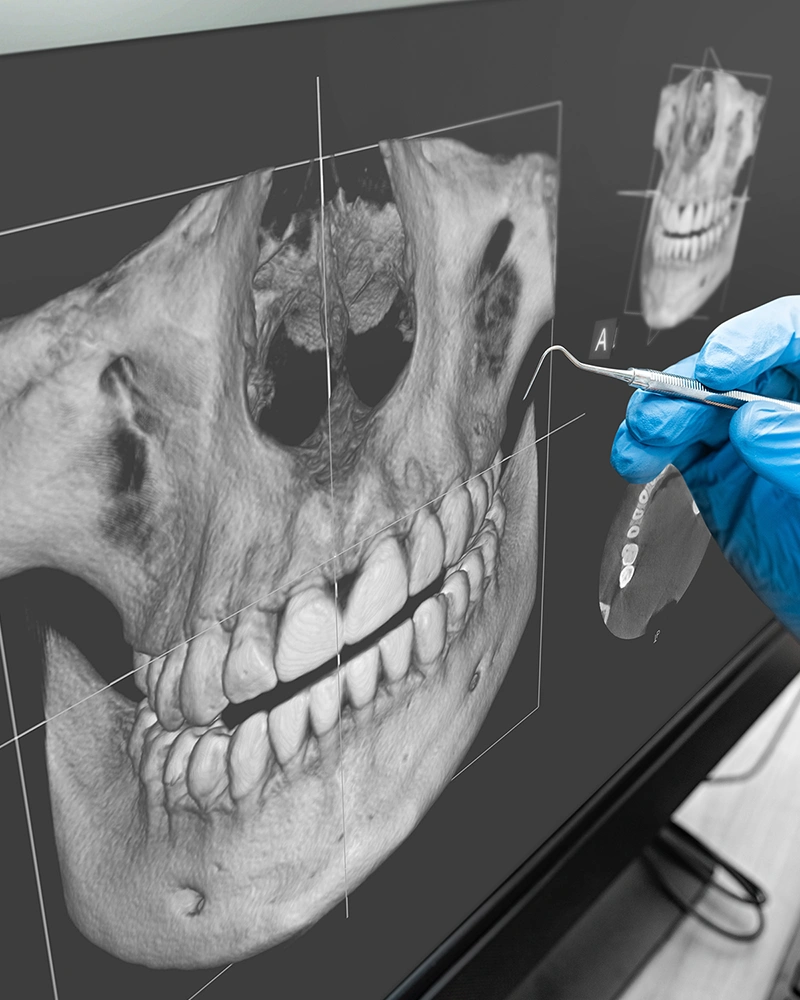
What imaging technology do most dental practices use?
Most dental practices use 2D imaging technology to diagnose toothaches and tooth-related infections. Such machinery is considered to be standard-of-care: Any dental practice will have this technology on-site.
What is a CBCT 3D Imaging Machine?
This piece of machinery produces three-dimensional images of your teeth. This is an advanced piece of machinery, and most practices don’t have it on-site. This piece of technology is what separates a standard care practice from a cutting edge practice.

What are the benefits of having 3D Imaging on-site?
Saving Time and Money
Usually, when an endodontist or other dentist needs the accuracy of 3D imaging for treatment planning, they have to refer their patients to another facility. That means more running around and more spending. If it’s needed during a treatment, Dr. Kaplan won’t charge you anything extra for 3D imaging.* By having this technology on-site, Dr. Kaplan also saves you time and energy.
If it’s only used as a diagnostic tool during a consultation procedure, where no root canal treatment will be performed, then there will be a charge.
Immediate Pain Relief
Sometimes patients go to a specialist to find out where their pain comes from, but the endodontist can’t resolve it because the pain isn’t localized. Then they send you home, telling you to wait until it's localized. In the meantime, you have to suffer in pain until it becomes localized in one spot.

In many cases of non-localized pain, the 3D X-rays show where it’s coming from, allowing Dr. Kaplan to diagnose your pain immediately. This saves you time and suffering. Additionally, in difficult cases where 2D imaging can't locate the canals, 3D imaging will detect them. That enables Dr. Kaplan to figure out where to drill and maintain your tooth’s integrity.
There’s also a situation called calcified canals, for example, where the root canals are so small that 2D imaging can’t depict them. 3D imaging ensures that Dr. Kaplan finds all hidden canals. Sometimes root canals fail because the dentist didn’t find all the canals, or couldn’t negotiate all of them. 3D imaging will show you that the problem exists, allowing Dr. Kaplan to effectively treat the root canals.
Sometimes there are severe curves in root canals that don’t show up in 2D imaging. These cases are very difficult to negotiate. With 3D imaging, Dr. Kaplan can see exactly in which direction the curves are occurring. That way, he’ll know exactly where to drill, thus ensuring a successful treatment.
Fast Repairs
Many times when a root canal has to be retreated, a root canal specialist will use one invasive exploratory visit to diagnose the problem, and then treat the root canal during a separate visit. This one exploratory, invasive visit can often be bypassed with 3D imaging. Dr. Kaplan avoids the problem altogether, since the 3D imaging shows him exactly what and where the problem is, which means diagnosis and treatment can happen in one day.
Alternatively, sometimes dentists put posts in teeth, but in the wrong direction. That makes a hole in your tooth, which could be excruciating. A 2D X-ray won’t always reveal such a problem, but 3D imaging will. As a result, in such cases, Dr. Kaplan can remove the post and repair the hole immediately.
Accurate Diagnoses
There are certain infections that 2D X-rays just can’t detect. When two-dimensional imaging fails to show you what’s causing your toothache, often 3D X-rays will do the trick instead. That’s a huge boon to your health: Dr. Kaplan can figure out exactly where the infection is and how best to address it.

Sometimes patients come in with a situation called tooth resorption. This is where cells eat away at the tooth, either from within or without (internal or external resorption, respectively). Each problem requires a different treatment. 2D X-rays often can’t detect whether the resorption is internal or external, leaving it a matter of guesswork for the practitioner. That’s not the case with 3D imaging: Dr. Kaplan will get the diagnosis right the first time, which means he can prescribe the right treatment plan the first time.
Dr. Steven Kaplan’s cutting-edge, on-site technology makes him more than capable of addressing all of your endodontic needs quickly and correctly. Schedule an appointment with him by booking online today!
*If it’s only used as a diagnostic tool during a consultation procedure, where no root canal treatment will be performed, then there will be a charge.


























